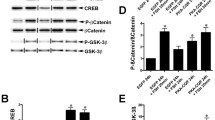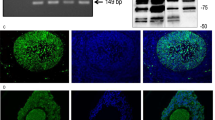Abstract
Cyclic AMP (cAMP), as a second messenger, plays a critical role in cellular signaling transduction. However, it is not clear how this apparently identical cAMP signal induces divergent physiological responses. The potential explanation that cAMP signaling is compartmentalized was proposed by Buxton and Brunton twenty years ago. Compartmentalization of cAMP signaling allows spatially distinct pools of protein kinase A (PKA) to be differently activated. Research on cAMP signaling has regained impetus in many fields of life sciences due to the progress in understanding cAMP signaling complexity and functional diversity. The cAMP/PKA signaling compartments are maintained by A-kinase anchoring proteins (AKAPs) which bind PKA and other signaling proteins, and by PDEs which hydrolyse cAMP and thus terminate PKA activity. PDE4 enzymes belong to PDE superfamily and stand at a crossroad that allows them to integrate various signaling pathways with that of cAMP in spatially distinct compartments. In the current review, the nomenclature, taxonomy and gene expression of PDE4, and the system and region of its effect are described. In addition, the idiographic molecules, mechanisms, and regulation models of PDE4 are summarized. Furthermore, the important roles PDE4 plays in the maturation of rat granulosa cells and cAMP signaling compartmentalization are discussed.
Similar content being viewed by others
References
Houslay M D, Schafer P, Zhang K Y. Keynote review: Phosphodiesterase-4 as a therapeutic target. Drug Discov Today, 2005, 10(22): 1503–1519
Conti M, Richter W, Mehats C, et al. Cyclic AMP-specific PDE4 phosphodiesterases as critical components of cyclic AMP signaling. J Biol Chem, 2003, 278(8): 5493–5496
Houslay M D, Milligan G. Tailoring cAMP signalling responses through isoform multiplicity. Trends Biochem Sci, 1997, 22: 217–224
Beavo J A, Brunton L L. Cyclic nucleotide research-still expanding after half a century. Nat Rev Mol Cell Biol, 2002, 3: 710–718
Evellin S, Mongillo M, Terrin A, et al. Measuring dynamic changes in cAMP using fluorescence resonance energy transfer. Methods Mol Biol, 2004, 284: 259–270
Houslay M D, Adams D R. PDE4 cAMP phosphodiesterases: Modular enzymes that orchestrate signalling cross-talk, desensitization and compartmentalization. Biochem J, 2003, 370(Pt 1): 1–18
Henn V, Stefan E, Baillie G S, et al. Compartmentalized cAMP signalling regulates vasopressin-mediated water reabsorption by controlling aquaporin-2. Biochem Soc Trans, 2005, 33(Pt 6): 1316–1318
Huang T, McDonough C B, Abel T. Compartmentalized PKA signaling events are required for synaptic tagging and capture during hippocampal late-phase long-term potentiation. Eur J Cell Biol, 2006, 85: 635–642
Alto N M, Scott J D. The role of A-kinase anchoring proteins in camp-mediated signal transduction pathways. Cell Biochem Biophys, 2004, 40(3 Suppl): 201–208
Levine C G, Mitra D, Sharma A, et al. The efficiency of protein compartmentalization into the secretory pathway. Mol Biol Cell, 2005, 16(1): 279–291
Wang Z, Huang R, Pan L, et al. Molecular structures, physiological roles and regulatory mechanisms of cyclic nucleotide-gated ion channels. Chin J Biochem Mol Biol (in Chinese), 2006, 22(4): 282–288
Dousa T P. Cyclic-3′,5′-nucleotide phosphodiesterase isozymes in cell biology and pathophysiology of the kidney. Kidney Int, 1999, 55(1): 29–62
Matsumoto T, Kobayashi T, Kamata K. Phosphodiesterases in the vascular system. J Smooth Muscle Res, 2003, 39(4): 67–86
Beard M B, Olsen A E, Jones R E, et al. UCR1 and UCR2 domains unique to the cAMP-specific phosphodiesterase family form a discrete module via electrostatic interactions. J Biol Chem, 2000, 275: 10349–10358
Lugnier C. Cyclic nucleotide phosphodiesterase (PDE) superfamily: A new target for the development of specific therapeutic agents. Pharmacol Therapeut, 2006, 109: 366–398
Torphy T J. Phosphodiesterase isozymes: Molecular targets for novel antiasthma agents. Am J Respir Crit Care Med, 1998, 157(2): 351–370
Conti M, Jin S L. The molecular biology of cyclic nucleotide phosphodiesterases. Prog Nucleic Acid Res Mol Biol, 1999, 63: 1–38
Conti M. Phosphodiesterases and cyclic nucleotide signaling in endocrine cells. Mol Endocrinol, 2000, 14(9): 1317–1327
Mehats C, Andersen C B, Filopanti M, et al. Cyclic nucleotide phosphodiesterases and their role in endocrine cell signaling. Trends Endocrinol Metab, 2002, 13(1): 29–35
Huston E, Houslay T M, Baillie G S, et al. cAMP phosphodiesterase-4A1 (PDE4A1) has provided the paradigm for the intracellular targeting of phosphodiesterases, a process that underpins compartmentalized cAMP signalling. Biochem Soc Trans, 2006, 34(Pt 4): 504–509
Jin S L, Bushnik T, Lan L, et al. Subcellular localization of rolipram-sensitive, cAMP-specific phosphodiesterases. Differential targeting and activation of the splicing variants derived from the PDE4D gene. J Biol Chem, 1998, 273(31): 19672–19678
Perry S J, Baillie G, Kohout T A, et al. Targeting of cyclic AMP degradation to beta 2-adrenergic receptors by beta-arrestins. Science, 2002, 298: 834–836
Baillie G S, Houslay M D. Arrestin times for compartmentalised cAMP signalling and phosphodiesterase-4 enzymes. Curr Opin Cell Biol, 2005, 17(2): 129–134
Wong W, Scott J D. AKAP signalling complexes: Focal points in space and time. Nat Rev Mol Cell Biol, 2004, 5(12): 959–970
Bolger G B, Baillie G S, Li X, et al. Scanning peptide array analyses identify overlapping binding sites for the signalling scaffold proteins, beta-arrestin and RACK1, in cAMP-specific phosphodiesterase PDE4D5. Biochem J. 2006, 398(1): 23–36
Tasken K, Stokka A J. The molecular machinery for cAMP-dependent immunomodulation in T-cells. Biochem Soc Trans. 2006, 34(Pt 4): 476–479
Tasken K, Aandahl E M. Localized effects of cAMP mediated by distinct routes of protein kinase A. Physiol Rev, 2004, 84: 137–167
Cooper D M. Compartmentalization of adenylate cyclase and cAMP signalling. Biochem Soc Trans, 2005, 33(Pt 6): 1319–1322
Houslay M D, Baillie G S. Phosphodiesterase-4 gates the ability of protein kinase A to phosphorylate G-protein receptor kinase-2 and influence its translocation. Biochem Soc Trans, 2006, 34(Pt 4): 474–475
Willoughby D, Wong W, Schaack J, et al. An anchored PKA and PDE4 complex regulates subplasmalemmal cAMP dynamics. EMBO J, 2006, 25(10): 2051–2061
Ji J, Zhang X, Li B. β-adrenergic modulation of in vivo long-term potentiation in area CA1 and its role in spatial learning in rats. Sci China Ser C-Life Sci, 2003, 46(6): 605–614
McConnachie G, Langeberg L K, Scott J D. AKAP singaling complexs: Getting to the heart of the matter. Trends in Mol Med, 2006, 12(7): 317–323
Lim J, Pahlke G, Conti M. Activation of the cAMP-specific phosphodiesterase PDE4D3 by phosphorylation. Identification and function of an inhibitory domain. J Biol Chem, 1999, 274: 19677–19685
Hoffmann R, Wilkinson IR, McCallum JF, et al. cAMP-specific phosphodiesterase HSPDE4D3 mutants which mimic activation and changes in rolipram inhibition triggered by protein kinase A phosphorylation of Ser-54: Generation of a molecular model. Biochem J, 1998, 333: 139–149
Busch C J, et al. Nitric oxide induces phosphodiesterasse 4B expression in rat pulmonary artery smooth muscle cells. Am J Physiol Lung Cell Mol Physiol. 2006, 290(4): L747–L753
Tian Z X, Mao X J, Su W. Exogenous cAMP upregulates the expression of glnII and glnK-amtB genes in Sinorhizobium meliloti 1021. Chin Sci Bull, 2006, 51(16): 1982–1985
Li P, Wang Z W, Yan J. Neuro-protective effects of CNTF on hippocampal neurons via an unknown signal transduction pathway. Chin Sci Bull, 2006, 51(1): 48–53
Li Z, Sun Y, Mao X. cAMP receptor protein (CRP) downregulates Klebsiella pneumoniae nif promoters in Escherichia coli. Chin Sci Bull, 2002, 47(19): 1622–1628
Oki N, Takahashi S I, Hidaka H, et al. Short term feedback regulation of cAMP in FRTL-5 thyroid cells. Role of PDE4D3 phosphodiesterase activation. J Biol Chem, 2000, 275: 10831–10837
Jin S-L C, Richard F, Kuo W P, et al. Impaired growth and fertility of cAMP-specific phosphodiesterase PDE4D-deficient mice. Proc Natl Acad Sci USA, 1999, 96: 11998–12003
Hansen G, Jin S-L C, Umetsu D, et al. Absence of muscarinic cholinergic airway responses in mice deficient in the cyclic nucleotide phosphodiesterase PDE4D. Proc Natl Acad Sci USA, 2000, 97: 6751–3756
Hoffmann R., Baillie G S, MacKenzie S J, et al. The MAP kinase ERK2 inhibits the cAMP-specific phosphodiesterase, HSPDE4D3 by phosphorylating it at Ser579. EMBO J, 1999, 18: 893–903
Houslay M D, Kolch W. Cell-type specific integration of cross-talk between extracellular signal-regulated kinase and cAMP signaling. Mol Pharmacol, 2000, 58: 659–668
Dodge-Kafka K L, Soughayer J, Pare G C, et al. The protein kinase A anchoring protein mAKAP coordinates two integrated cAMP effector pathways. Nature, 2005, 437: 574–578
Park J Y, Richard F, Chun S Y, et al. Phosphodiesterase regulation is critical for the differentiation and pattern of gene expression in granulosa cells of the ovarian follicle. Mol Endocrinol, 2003, 17(6): 1117–1130
Shi F, Perez E, Wang T, et al. Stage and cell-specific expression of soluble guanylyl cyclase alpha and beta subunits, cGMP-Dependent protein kinase I-alpha and I-beta, cyclic nucleotide-gated channel subunit-1 in the rat testis. J Androl, 2005, 26(2): 258–263
Shi F, Stewart R L, Pere E, et al. Cell-specific expression and regulation of soluble guanylyl cyclase alpha and beta subunit in the rat ovary. Bio Reprod, 2004, 70: 1552–1561
Shi F, LaPolt P S. Relationship between FoxO1 protein levels and follicular development, atresa, and luteinization. J Endocr. 2003, 179: 195–203
Li X, Jiang Y, Wang Z, et al. Regulation of FoxO1 transcription factor by nitric oxide and cyclic GMP in cultured rat granulosa cells. Zoolog Sci, 2005, 22: 1339–1346
Li X, Xie Z, Shi F. Involvement of forkhead box proteins in apoptosis and oncogenesis. Prog Biochem Biophys (in Chinese), 2005, 32(7): 600–606
Shen Z, Zhao X, Cao Y. Regulation of mouse blastocyst adhesion, outgrowth and secretion of matrix metalloproteinase-2 by cGMP and nitric oxide in vitro. Chin Sci Bull, 2004, 49(11): 1142–1145
Conti M, Andersen C B, Richard F, et al. Role of cyclic nucleotide signaling in oocyte maturation. Mol Cell Endocrinol, 2002, 187(1–2): 153–159
Paruthiyil S, Majdoubi M E, Conti M, et al. Phosphodiesterase expression targeted to gonadotropin-releasing hormone neurons inhibits luteinizing hormone pulses in transgenic rats. Proc Natl Acad Sci USA, 2002, 99(26): 17191–17196
Sadler SE. Type III phosphodiesterase plays a necessary role in the growth-promoting actions of insulin, insulin-like growth factor-I, and Ha p21ras in Xenopus laevis oocytes. Mol Endocrinol, 1991, 5: 1939–1946
Author information
Authors and Affiliations
Corresponding author
Additional information
Supported by the National Natural Science Foundation of China (Grant No. 30571335) and a Grant-in-Aid for Innovatory Training of Graduated Students in Jiangsu Province, China
About this article
Cite this article
Wang, Z., Shi, F. Phosphodiesterase 4 and compartmentalization of cyclic AMP signaling. CHINESE SCI BULL 52, 34–46 (2007). https://doi.org/10.1007/s11434-007-0025-3
Received:
Accepted:
Issue Date:
DOI: https://doi.org/10.1007/s11434-007-0025-3




